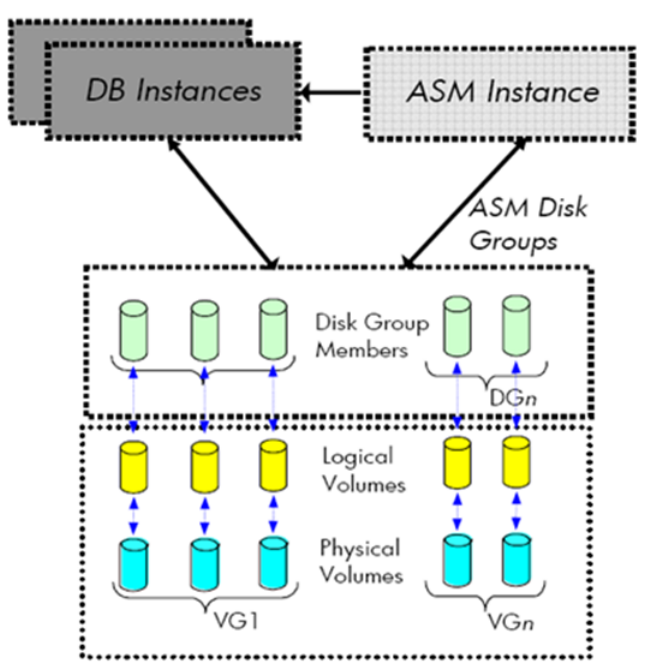HP Serviceguard Enterprise Cluster Master Toolkit User Guide (5900-2145, April 2013)
Table Of Contents
- HP Serviceguard Enterprise Cluster Master Toolkit User Guide
- Contents
- 1 Introduction
- 2 Using the Oracle Toolkit in an HP Serviceguard Cluster
- Overview
- Supported Versions
- Support for Oracle Database Without ASM
- Supporting Oracle ASM Instance and Oracle Database with ASM
- What is Automatic Storage Management (ASM)?
- Why ASM over LVM?
- Configuring LVM Volume Groups for ASM Disk Groups
- Sample command sequence for configuring LVM Volume Groups
- Serviceguard support for ASM on HP-UX 11i v3 onwards
- Framework for ASM support with Serviceguard
- Installing, Configuring, and Troubleshooting
- Setting up DB instance and ASM instance
- Setting up the Toolkit
- ASM Package Configuration Example
- Modifying a Legacy Database Package Using an Older Version of Oracle ECMT Scripts to use the Scripts Provided for ASM Support
- Adding the Package to the Cluster
- Node-specific Configuration
- Error Handling
- Network Configuration
- Database Maintenance
- Configuring and packaging Oracle single-instance database to co-exist with SGeRAC packages
- Configuring Oracle single-instance database that uses ASM in a Coexistence Environment
- Attributes newly added to ECMT Oracle toolkit
- Configuring a modular failover package for an Oracle database using ASM in a coexistence environment
- Configuring a legacy failover package for an Oracle database using ASM in a Coexistence Environment
- ECMT Oracle Toolkit Maintenance Mode
- Supporting EBS database Tier
- Oracle ASM Support for EBS DB Tier
- 3 Using the Sybase ASE Toolkit in a Serviceguard Cluster on HP-UX
- Overview
- Sybase Information
- Setting up the Application
- Setting up the Toolkit
- Sybase Package Configuration Example
- Creating the Serviceguard package using Modular method
- Adding the Package to the Cluster
- Node-specific Configuration
- Error-Handling
- Network configuration
- Database Maintenance
- Cluster Verification for Sybase ASE Toolkit
- 4 Using the DB2 Database Toolkit in a Serviceguard Cluster in HP-UX
- 5 Using MySQL Toolkit in a HP Serviceguard Cluster
- MySQL Package Configuration Overview
- Setting Up the Database Server Application
- Setting up MySQL with the Toolkit
- Package Configuration File and Control Script
- Creating Serviceguard Package Using Modular Method
- Applying the Configuration and Running the Package
- Database Maintenance
- Guidelines to Start Using MySQL Toolkit
- 6 Using an Apache Toolkit in a HP Serviceguard Cluster
- 7 Using Tomcat Toolkit in a HP Serviceguard Cluster
- Tomcat Package Configuration Overview
- Multiple Tomcat Instances Configuration
- Configuring the Tomcat Server with Serviceguard
- Setting up the Package
- Creating Serviceguard Package Using Modular Method
- Setting up the Toolkit
- Error Handling
- Tomcat Server Maintenance
- Configuring Apache Web Server with Tomcat in a Single Package
- 8 Using SAMBA Toolkit in a Serviceguard Cluster
- 9 Using HP Serviceguard Toolkit for EnterpriseDB PPAS in an HP Serviceguard Cluster
- 10 Support and Other resources
- 11 Acronyms and Abbreviations
- Index

• should not span multiple PVs.
• and should not share a PV with other LVs.
The idea is that ASM provides the mirroring, striping, slicing, and dicing functionality as needed
and LVM supplies the multipathing functionality not provided by ASM. Figure 2 indicates this
one-to-one mapping between LVM PVs and LVs used as ASM disk group members.
Further, because of the default retry behavior of LVM, the I/O operation on an LVM LV might take
an indefinitely long time. This behavior might impede ASM retry and rebalance capabilities; hence,
a finite timeout must be configured for each LVM LV.
For example, the timeout can be configured to the value (total number of physical paths to the PV
* PV timeout), providing enough time for LVM to try all available paths, if needed.
The PVs used in an ASM disk group can be organized into LVM volume groups as desired by the
customer. In the example shown in Figure 2, for each ASM disk group, the PVs corresponding to
its members are organized into a separate LVM volume group.
The LVM volume groups are marked as exclusive volume groups and exported across the
Serviceguard cluster using standard Serviceguard procedures. As noted above, multiple physical
paths to each physical volume must be configured using the LVM PV Links feature or a separate
multiathing product, such as HP StorageWorks Secure Path.
Figure 2 Oracle database storage hierarchy without and with ASM
Sample command sequence for configuring LVM Volume Groups
Below is an example of a command sequence that can be used to prepare LVM Logical Volumes
for use by ASM to meet the requirements specified in Figure 2. The scenario for the example is
that we are creating a new volume group named vgora_asm with two PVs, each with two physical
paths. The physical paths for the first PV are /dev/dsk/c9t0d1 and /dev/dsk/c10t0d1 and
those for the second PV are /dev/dsk/c9t0d2 and /dev/dsk/c10t0d2.
Supporting Oracle ASM Instance and Oracle Database with ASM 33










